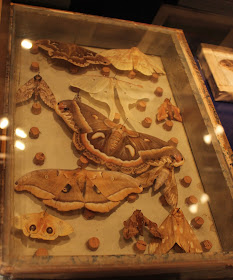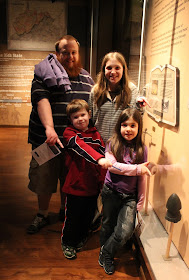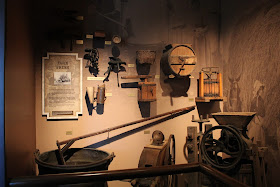On our way to Indiana for Thanksgiving we stopped to check out the West Virginia State Museum. It is a fabulous state museum and even better it is FREE. We were pleasantly surprised by how beautiful it was and how much time we enjoyed spending there. Totally worth the stop!

In the lobby of the WV State Museum are these incredible chandeliers. Aren't they gorgeous?!


We loved seeing this beautiful 33 Star Flag. In April 1861 this flag was removed from the Jefferson County Courthouse when Virginia seceded from the United States and joined the Confederacy.

The museum exhibits are in the basement and quite extensive. Before entering the new Discovery Rooms (the main part of the WV State Museum) there is a large room full of artifacts from the early years of the WV State Museum. Note: I'm only going to focus on our favorite parts of the museum.




One of the highlights was seeing Confederate Money.


We love when museums cater to children and this one does an incredible job of making itself kid-friendly. They provide a Museum Activity Book for free at the Visitor's Desks. Our kids had a blast trying to find everything on the Discovery Rooms Scavenger Hunt.
In Discovery Room 2: Prehistoric People we found an artifact called the Braxton County Rune Stone from Braxton County, West Virginia. Needless to say Brax thought it was cool!


Discovery Room 3: Conflict and Settlement had a ton of information about West Virginia's involvement in the French & Indian War and the Revolutionary War. Around 1770, George Washington presented the sword below to Col. Garrett Van Meter, an early settler of Fort Pleasant, WV.


There was an exhibit about slavery in West Virginia. It was both moving and educational. My heart broke when we read the 1856 note of sale for Alick. Nothing is known about his life after the photo below was taken of him.
.jpg)


The painting below depicts a 60 yard dash Betty Zane took from Fort Henry to a nearby cabin to get more gunpowder during the Revolutionary War.


Discovery Room 4: Frontier Life focused on domestic life on the frontier. The exhibit is actually in an original log cabin from Monaville, WV which was built in the mid 1800s. Delaney loved the butter churn. She wished we had one. The antique china they displayed was beautiful.


One of my favorite displays was the 1846 pen-and-ink mourning picture and its pinecone frame. It memorializes the deaths of a father and son, Samuel and James McCoy, who died within three months of each other. They are buried in the Pratt Cemetery located in Kanawha County, WV.


Isn't this dress absolutely darling!

In 1845 James Presley Ball, a free African American, took this daguerreotype of White Sulphur Springs, WV. This photo is one of the oldest pictures of West Virginia. He was such a talented photographer!

Our family loved the Discovery Room 6: The War within a State which focuses on the Civil War. As you walk down into the room there is an incredible early 15 Star Confederate flag that was captured on June 3, 1861 by the First West Virginia Infantry of the Union army during the Battle of Phillipi. This flag is very unusual because it reflects the 11 seceded states (South Carolina, Mississippi, Florida, Alabama, Georgia, Louisiana, Texas, Virginia, Arkansas, North Carolina & Tennessee), 2 Dual Government States (Kentucky & Missouri) and the 2 Seceding Territories (Oklahoma & Arizona). The Confederate States of America clearly was hopeful that the Dual Government States and Seceding Territories would actually become part of their "country". Love how the glass reflects the Civil War mural on the opposite wall.





Thrilled to find a Hotchkiss shell used in the Battle of Charleston.


After the Civil War Ann Reeves Jarvis organized a Mothers' Friendship Day for all soldiers from both sides and their families which became an annual tradition for several years. She always wanted a special day to celebrate mothers so two years after her death her daughter Anna Jarvis campaigned to make Mother's Day a national holiday.

The Craigo brothers, Harrison and Madison Craigo, actually fought on both sides during the Civil War. Unbeknownst to us it was not uncommon for people in the region to switch sides.

One of the highlights of this Discovery Room is the cannon.

In the Discovery Room 8: The Big City there were neat displays about immigrants that came and settled in West Virginia.



In Discovery Room 9: The Family Farm there is a neat exhibit that focuses on farm life. It contains a bunch of farm tools.

Just loved this beautiful quilt!


By far one of the coolest displays we saw had photos of the infamous Hatfield and McCoy families. The Hatfield-McCoy Feud began in 1865 when Union Army Pvt. Asa Harmon McCoy (Randolph McCoy's younger brother) was shot and killed by the Hatfield's Wildcats Gang, most likely by Jim Vance (uncle of Devil Anse). The feud escalated when Roseanna McCoy (daughter of Randolph McCoy) and Johnse Hatfield (son of Devil Anse Hatfield) fell in love. He left the pregnant Roseanna before the birth of their daughter, Sarah Elizabeth McCoy Hatfield. Unfortunately, this feud continued until 1888 and resulted in dozens of deaths.


(Funeral of "Devil Anse" in 1921)



Seriously, isn't this the most stunning library!

Discovery Room 10: The Company Store was a really cool. It is huge and contains a little town. There are lots of antiques to look at. My girls absolutely loved the girl clothes, especially the shoes.




The clothes were so dainty and feminine.


In Discovery Room 11: Changing Roles of Women the kids got the biggest kick out of playing with the telephone switchboard. Hotch told the kids about how his Grandma used to be a telephone operator.

Love this photo of Captain Hotch! In Discovery Room 13: Boats and Rivers had an enormous pilot wheel from the O. F. Shearer from 1919. This room also focuses on devastating floods. One such flood occurred in 1937 after 26 straight days of rain. Tragically, this flood resulted in the deaths of 368 people and 1 million people losing their homes.


No West Virginia State Museum would be complete without an exhibit on the coal mining industry. We learned a lot in Discovery Room 15: The Mining Life about the people in the coal mining industry during the late 1800s and early 1900s.



Sad to hear that on January 3, 1921 the West Virginia State Capitol caught on fire and only a few items were saved from it.


Of course there was an exhibit on moonshine. This one was fun!


Isn't this neat! There was a miniature city with lots of buildings to check out.

Loved the soda counter and drug store exhibit toward the end of the museum. Our little ones loved the phone booth because it reminded them of Doctor Who's "blue box".



Discovery Room 23: From Here to There has a road along the floor that leads you to displays about West Virginia transportation and bridges.


Love the New River Gorge Bridge recreation. Hotch and I were lucky to actually visit it back in October 2011 while on our way up to Pittsburgh, PA. It is breath-taking!


Lastly, this double reverse glass seal painting is from the ceiling of the House of Representatives chamber in the United States Capitol. It was installed in 1867 after West Virginia became a state and it was removed/transferred to West Virginia in 1949.




No comments:
Post a Comment